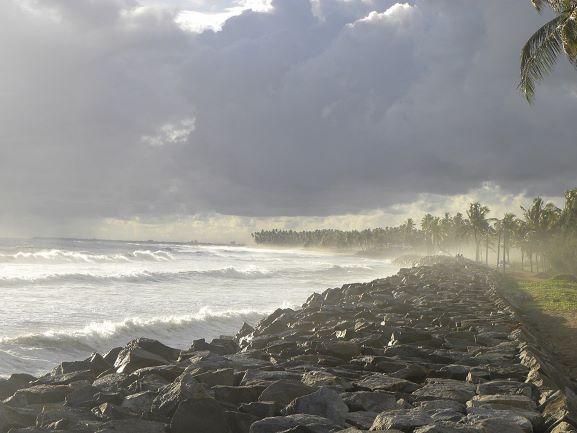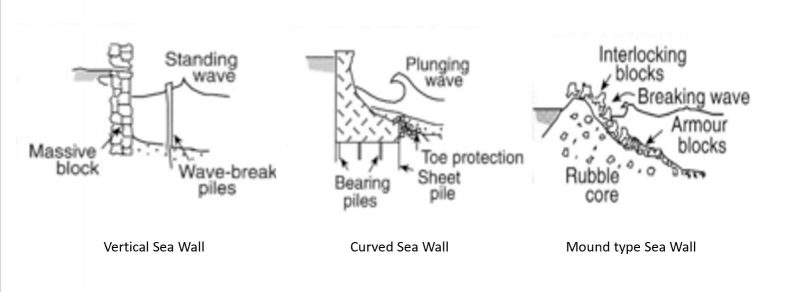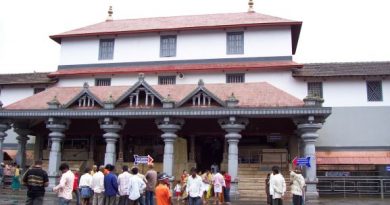Why We Need Sea Walls

What is a Sea Wall?
A sea wall is a structure or embankment erected to prevent the sea encroaching on or eroding an area of land. Sea walls are generally massive concrete structures placed along a considerable stretch of shoreline at urban beaches. The purpose of a sea wall is to protect areas of human habitation, conservation and leisure activities from the action of tides, waves, or tsunamis.
Historically the structure helped in separating land and water areas, but in recent times it has garnered interest all over the world as a means to not only stop erosion but also stop the sea from entering the coastal areas. Many residential areas which have come dangerously close to the shorelines are now facing the danger of being swept away by any future cyclone or tsunami triggered elsewhere.
Types of sea walls
Depending upon the sea level, movement of air, pressure belt formation and history of sea-related storms, cyclones and other natural disasters, a variety of sea walls are put in place to tackle the rise of the sea.
The design and type of sea wall that is appropriate depends on aspects specific to the location, including the surrounding erosion processes. There are three main types of seawalls: vertical, curved or stepped, and mounds

- Vertical seawalls are built in particularly exposed situations. These reflect wave energy. Under storm conditions a non-breaking standing wave pattern can form, resulting in a stationary clapotic wave which moves up and down but does not travel horizontally. These waves promote erosion at the toe of the wall and can cause severe damage to the sea wall. In some cases, piles are placed in front of the wall to lessen wave energy slightly.
- Curved or stepped seawalls are designed to enable waves to break to dissipate wave energy and to repel waves back to the sea. The curve can also prevent the wave overtopping the wall and provides additional protection for the toe of the wall.
- Mound type seawalls, using revetments or riprap, are used in less demanding settings where lower energy erosional processes operate. The least exposed sites involve the lowest-cost bulkheads and revetments of sandbags or geotextiles. These serve to armor the shore and minimize erosion and may be either watertight or porous, which allows water to filter through after the wave energy has been dissipated.
| Advantages | Disadvantages |
| Long term solution in comparison to soft beach nourishment. | Expensive to construct. |
| Effectively minimizes loss of life in extreme events and damage to property caused by erosion. | May be considered aesthetically unattractive. |
| Can exist longer in high energy environments in comparison to ‘soft’ engineering methods. | Reflected energy of waves leading to scour at base. |
| Can be used for recreation and sightseeing. | Can disrupt natural shoreline processes and destroy shoreline habitats such as wetlands and intertidal beaches. |
| Forms a hard and strong coastal defense. | Altered sediment transport processes can disrupt sand movement that can lead to increased erosion downdrift from the structure. This can cause beaches to dissipate, rendering them useless for beachgoers. |
On 26 December, 2004 the devastating tsunami hit India’s south-eastern coastline and killed thousands. However, the former French colonial enclave of Pondicherry escaped unscathed. This was primarily due to French engineers who had constructed (and maintained) a massive stone seawall during the time when the city was a French colony.
Additionally, A report published by the United Nations Environment Programme (UNEP) suggested that the tsunami of 26 December 2004 caused less damage in the areas where natural barriers were present, such as mangroves, coral reefs or coastal vegetation.
As you can imagine or would have seen them, a sea wall is a static feature and will conflict with the dynamic nature of the coast and impede the exchange of sediment between land and sea. While they prevent further shoreline erosion, they do not deal with the causes of erosion.
Due to its variable effect there has been mixed reaction to its construction in India.
For instance, residents of Chellanam in Kochi on June 18, marched in protest and picketed the panchayat office against the delay in constructing the sea wall. In the same week when the southwest monsoons hit the coastal village in Ernakulam district, the weakening of existing seawall structure and incomplete construction of the new one caused houses to be inundated with sea water within 2 days. Here the Geotube seawall project is still under construction. Another case that made news was from the coast of Ponnani and adjacent areas which were damaged as the turbid Arabian Sea carved into the coast at places where the sea walls were missing.
Hundreds of people living in the coast at Aliyarpalli, Marakkadavu, Murinjazhi, Puthuponnani, Azhikkal, Veliyankode, Thannithura, Palappetty and Kappirikkad evacuated their houses following the threat of sea erosion.

While on the other side, climate experts maintain that sea walls are not part of the solution.
Dr Kakani Nageswara Rao, Professor Emeritus, Department of Geo-Engineering, Andhra University says that Odisha coast is facing severe erosion due to climate change, construction of sea walls and denudation of mangrove forests.
Rao is opposing the construction of 600-metre geo-synthetic sea wall at the seaside Pentha village in Kendrapara district at a cost of Rs 39 crore.
The state government had built Odisha’s first geo-filter tube sea wall at the seaside village three years back to protect it from the onslaught of the sea without consulting environmentalists and scientists. “The Pentha beach is permanently lost due to construction of the sea wall,” he said.
The professor said the governments of Kerala, Andhra Pradesh, Puducherry and Tamil Nadu had constructed sea walls in the past but they did not prevent the ingress of the sea during tsunami.
In Kerala, Friends of Marine Life (FML), a non-goverment organization (NGO), has also come out against the ongoing construction of a double-layered sea wall, adjacent to the Directorate of Ports near Valiyathura sea bridge. The NGO claimed that the structure would further accelerate the erosion up till Shangumugham beach.
“The double-layered seawall will result in sea erosion to a greater extent. There are chances of the water gushing towards the Valiyathura sea bridge’s northern side, which has a football ground… The signal station was destroyed by the rough sea years ago and the seawall is being constructed in front of the Directorate of Ports. This proves that the wall is solely constructed to protect their buildings. None of the CRZ guidelines has been followed. This will lead to severe ecological impact,” says Robert Panipilla, FML founding director. He also wants a feasibility study to be conducted based on the CRZ norms, along with the Kerala Coastal Zone Management Authority’s sanction.
The Sea wall, like many other construction structures, remains a contemptuous topic between the coastal area dwellers and the ecologists but a midway can be achieved if the structures are made keeping in mind the welfare of both man and animal. Ocean waves have become more severe due to human-made climatic conditions (read Global Heating). More research and development is needed to come up with better and more efficient sustainable infrastructures that can help the ocean’s ecosystem eventually. Sea walls may become a temporary solution for the time being till the coastal communities relocate but natural practices like mangrove forests, coral reefs, and vegetation offer many more benefits in the long run which would save lives as well as provide livelihoods to these vulnerable communities.




